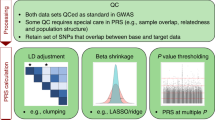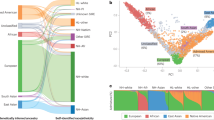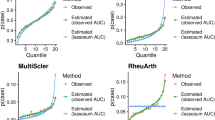Abstract
Polygenic risk scores (PRSs), which often aggregate results from genome-wide association studies, can bridge the gap between initial discovery efforts and clinical applications for the estimation of disease risk using genetics. However, there is notable heterogeneity in the application and reporting of these risk scores, which hinders the translation of PRSs into clinical care. Here, in a collaboration between the Clinical Genome Resource (ClinGen) Complex Disease Working Group and the Polygenic Score (PGS) Catalog, we present the Polygenic Risk Score Reporting Standards (PRS-RS), in which we update the Genetic Risk Prediction Studies (GRIPS) Statement to reflect the present state of the field. Drawing on the input of experts in epidemiology, statistics, disease-specific applications, implementation and policy, this comprehensive reporting framework defines the minimal information that is needed to interpret and evaluate PRSs, especially with respect to downstream clinical applications. Items span detailed descriptions of study populations, statistical methods for the development and validation of PRSs and considerations for the potential limitations of these scores. In addition, we emphasize the need for data availability and transparency, and we encourage researchers to deposit and share PRSs through the PGS Catalog to facilitate reproducibility and comparative benchmarking. By providing these criteria in a structured format that builds on existing standards and ontologies, the use of this framework in publishing PRSs will facilitate translation into clinical care and progress towards defining best practice.
This is a preview of subscription content, access via your institution
Access options
Access Nature and 54 other Nature Portfolio journals
Get Nature+, our best-value online-access subscription
$29.99 / 30 days
cancel any time
Subscribe to this journal
Receive 51 print issues and online access
$199.00 per year
only $3.90 per issue
Buy this article
- Purchase on Springer Link
- Instant access to full article PDF
Prices may be subject to local taxes which are calculated during checkout

Similar content being viewed by others
References
Morales, J. et al. A standardized framework for representation of ancestry data in genomics studies, with application to the NHGRI-EBI GWAS Catalog. Genome Biol. 19, 21 (2018).
MacArthur, J. et al. The new NHGRI-EBI Catalog of published genome-wide association studies (GWAS Catalog). Nucleic Acids Res. 45, D896–D901 (2017).
Claussnitzer, M. et al. A brief history of human disease genetics. Nature 577, 179–189 (2020).
Visscher, P. M., Brown, M. A., McCarthy, M. I. & Yang, J. Five years of GWAS discovery. Am. J. Hum. Genet. 90, 7–24 (2012).
Visscher, P. M. et al. 10 years of GWAS discovery: biology, function, and translation. Am. J. Hum. Genet. 101, 5–22 (2017).
Pasaniuc, B. & Price, A. L. Dissecting the genetics of complex traits using summary association statistics. Nat. Rev. Genet. 18, 117–127 (2017).
Lambert, S. A., Abraham, G. & Inouye, M. Towards clinical utility of polygenic risk scores. Hum. Mol. Genet. 28 (R2), R133–R142 (2019).
Torkamani, A., Wineinger, N. E. & Topol, E. J. The personal and clinical utility of polygenic risk scores. Nat. Rev. Genet. 19, 581–590 (2018). References 7 and 8 are useful reviews outlining the potential benefits and clinical uses of polygenic risk scores.
Martin, A. R. et al. Clinical use of current polygenic risk scores may exacerbate health disparities. Nat. Genet. 51, 584–591 (2019).
Chatterjee, N., Shi, J. & García-Closas, M. Developing and evaluating polygenic risk prediction models for stratified disease prevention. Nat. Rev. Genet. 17, 392–406 (2016).
Wray, N. R., Yang, J., Goddard, M. E. & Visscher, P. M. The genetic interpretation of area under the ROC curve in genomic profiling. PLoS Genet. 6, e1000864 (2010).
Dudbridge, F. Power and predictive accuracy of polygenic risk scores. PLoS Genet. 9, e1003348 (2013).
Pharoah, P. D. P. et al. Polygenic susceptibility to breast cancer and implications for prevention. Nat. Genet. 31, 33–36 (2002).
Zhang, Y., Qi, G., Park, J.-H. & Chatterjee, N. Estimation of complex effect-size distributions using summary-level statistics from genome-wide association studies across 32 complex traits. Nat. Genet. 50, 1318–1326 (2018).
Chatterjee, N. et al. Projecting the performance of risk prediction based on polygenic analyses of genome-wide association studies. Nat. Genet. 45, 400–405 (2013).
Mak, T. S. H., Porsch, R. M., Choi, S. W., Zhou, X. & Sham, P. C. Polygenic scores via penalized regression on summary statistics. Genet. Epidemiol. 41, 469–480 (2017).
Choi, S. W. & O’Reilly, P. F. PRSice-2: polygenic risk score software for biobank-scale data. GigaScience 8, giz082 (2019).
Vilhjálmsson, B. J. et al. Modeling linkage disequilibrium increases accuracy of polygenic risk scores. Am. J. Hum. Genet. 97, 576–592 (2015).
Wilkinson, M. D. et al. The FAIR Guiding Principles for scientific data management and stewardship. Sci. Data 3, 160018 (2016).
Ganguly, P. NIH funds centers to improve the role of genomics in assessing and managing disease risk. National Human Genome Research Institute https://www.genome.gov/news/news-release/NIH-funds-centers-to-improve-role-of-genomics-in-assessing-and-managing-disease-risk (2020).
Martens, F. K., Tonk, E. C. M. & Janssens, A. C. J. W. Evaluation of polygenic risk models using multiple performance measures: a critical assessment of discordant results. Genet. Med. 21, 391–397 (2019).
Janssens, A. C. J. W. Validity of polygenic risk scores: are we measuring what we think we are? Hum. Mol. Genet. 28, R143–R150 (2019).
Warrier, V. et al. Polygenic scores for intelligence, educational attainment and schizophrenia are differentially associated with core autism features, IQ, and adaptive behaviour in autistic individuals. Preprint at https://doi.org/10.1101/2020.07.21.20159228 (2020).
Matoba, N., Love, M. I. & Stein, J. L. Evaluating brain structure traits as endophenotypes using polygenicity and discoverability. Hum. Brain Mapp. https://doi.org/10.1002/hbm.25257 (2020).
Coleman, J. R. I. et al. Genome-wide gene-environment analyses of major depressive disorder and reported lifetime traumatic experiences in UK Biobank. Mol. Psychiatry 25, 1430–1446 (2020).
Kraft, P. & Aschard, H. Finding the missing gene–environment interactions. Eur. J. Epidemiol. 30, 353–355 (2015).
Janssens, A. C. J. W. et al. Strengthening the reporting of genetic risk prediction studies (GRIPS): explanation and elaboration. Eur. J. Hum. Genet. 19, 615 (2011). GRIPS was the first to propose standards for the reporting of risk prediction studies using genetics, and forms the basis of our updated PRS-RS.
von Elm, E. et al. Strengthening the reporting of observational studies in epidemiology (STROBE) statement: guidelines for reporting observational studies. Br. Med. J. 335, 806–808 (2007).
Little, J. et al. STrengthening the REporting of Genetic Association Studies (STREGA): an extension of the STROBE statement. PLoS Med. 6, e1000022 (2009).
Moons, K. G. M. et al. Transparent Reporting of a multivariable prediction model for Individual Prognosis or Diagnosis (TRIPOD): explanation and elaboration. Ann. Intern. Med. 162, W1–W73 (2015).
Choi, S. W., Mak, T. S.-H. & O’Reilly, P. F. Tutorial: a guide to performing polygenic risk score analyses. Nat. Protocols 15, 2759–2772 (2020).
Wojcik, G. L. et al. Genetic analyses of diverse populations improves discovery for complex traits. Nature 570, 514–518 (2019).
Buniello, A. et al. The NHGRI-EBI GWAS Catalog of published genome-wide association studies, targeted arrays and summary statistics 2019. Nucleic Acids Res. 47, D1005–D1012 (2019).
Lambert, S. A. et al. The Polygenic Score Catalog as an open database for reproducibility and systematic evaluation. Nat. Genet. https://doi.org/10.1038/s41588-021-00783-5 (2021). This paper describes the development and contents of the PGS Catalog (www.PGSCatalog.org), an open database of polygenic scores.
Thelwall, M. et al. Is useful research data usually shared? An investigation of genome-wide association study summary statistics. PLoS One 15, e0229578 (2020).
Burke, W. & Zimmern, R. Moving Beyond ACCE: An Expanded Framework for Genetic Test Evaluation (PHG Foundation, 2007).
Huo, D. et al. Comparison of breast cancer molecular features and survival by African and European ancestry in The Cancer Genome Atlas. JAMA Oncol. 3, 1654–1662 (2017).
Choi, J. et al. The associations between immunity-related genes and breast cancer prognosis in Korean women. PLoS One 9, e103593 (2014).
Marston, N. A. et al. Predicting benefit from evolocumab therapy in patients with atherosclerotic disease using a genetic risk score: results from the FOURIER trial. Circulation 141, 616–623 (2020).
Nikpay, M. et al. A comprehensive 1,000 Genomes-based genome-wide association meta-analysis of coronary artery disease. Nat. Genet. 47, 1121–1130 (2015).
Khera, A. V. et al. Genome-wide polygenic scores for common diseases identify individuals with risk equivalent to monogenic mutations. Nat. Genet. 50, 1219–1224 (2018).
Mars, N. et al. Polygenic and clinical risk scores and their impact on age at onset and prediction of cardiometabolic diseases and common cancers. Nat. Med. 26, 549–557 (2020).
Elliott, J. et al. Predictive accuracy of a polygenic risk score-enhanced prediction model vs a clinical risk score for coronary artery disease. J. Am. Med. Assoc. 323, 636–645 (2020).
Inouye, M. et al. Genomic risk prediction of coronary artery disease in 480,000 adults: implications for primary prevention. J. Am. Coll. Cardiol. 72, 1883–1893 (2018).
Abraham, G. et al. Genomic prediction of coronary heart disease. Eur. Heart J. 37, 3267–3278 (2016).
Ganna, A. et al. Multilocus genetic risk scores for coronary heart disease prediction. Arterioscler. Thromb. Vasc. Biol. 33, 2267–2272 (2013).
Kullo, I. J. et al. Incorporating a genetic risk score into coronary heart disease risk estimates: effect on low-density lipoprotein cholesterol levels (the MI-GENES clinical trial). Circulation 133, 1181–1188 (2016).
Mavaddat, N. et al. Polygenic risk scores for prediction of breast cancer and breast cancer subtypes. Am. J. Hum. Genet. 104, 21–34 (2019).
Mars, N. et al. The role of polygenic risk and susceptibility genes in breast cancer over the course of life. Nat. Commun. 11, 6383 (2020).
Zhang, H. et al. Genome-wide association study identifies 32 novel breast cancer susceptibility loci from overall and subtype-specific analyses. Nat. Genet. 52, 572–581 (2020).
Zhang, X. et al. Addition of a polygenic risk score, mammographic density, and endogenous hormones to existing breast cancer risk prediction models: a nested case-control study. PLoS Med. 15, e1002644 (2018).
Lakeman, I. M. M. et al. Addition of a 161-SNP polygenic risk score to family history-based risk prediction: impact on clinical management in non-BRCA1/2 breast cancer families. J. Med. Genet. 56, 581–589 (2019).
Wilcox, A. N. et al. Prospective evaluation of a breast cancer risk model integrating classical risk factors and polygenic risk in 15 cohorts from six countries. Preprint at https://doi.org/10.1101/19011171 (2019).
Pal Choudhury, P. et al. Comparative validation of the BOADICEA and Tyrer-Cuzick breast cancer risk models incorporating classical risk factors and polygenic risk in a population-based prospective cohort. Preprint at https://doi.org/10.1101/2020.04.27.20081265 (2020).
Maas, P. et al. Breast cancer risk from modifiable and nonmodifiable risk factors among white women in the United States. JAMA Oncol. 2, 1295–1302 (2016).
Lee, A. et al. BOADICEA: a comprehensive breast cancer risk prediction model incorporating genetic and nongenetic risk factors. Genet. Med. 21, 1708–1718 (2019).
Garcia-Closas, M., Gunsoy, N. B. & Chatterjee, N. Combined associations of genetic and environmental risk factors: implications for prevention of breast cancer. J. Natl. Cancer Inst. 106, dju305 (2014).
Kapoor, P. M. et al. Combined associations of a polygenic risk score and classical risk factors with breast cancer risk. J. Natl. Cancer Inst. 113, djaa056 (2020).
Easton, D. F. et al. Gene-panel sequencing and the prediction of breast-cancer risk. N. Engl. J. Med. 372, 2243–2257 (2015).
Muranen, T. A. et al. Genetic modifiers of CHEK2*1100delC-associated breast cancer risk. Genet. Med. 19, 599–603 (2017).
Kuchenbaecker, K. B. et al. Evaluation of polygenic risk scores for breast and ovarian cancer risk prediction in BRCA1 and BRCA2 mutation carriers. J. Natl. Cancer Inst. 109, djw302 (2017).
Fahed, A. C. et al. Polygenic background modifies penetrance of monogenic variants for tier 1 genomic conditions. Nat. Commun. 11, 3635 (2020.
Barnes, D. R. et al. Polygenic risk scores and breast and epithelial ovarian cancer risks for carriers of BRCA1 and BRCA2 pathogenic variants. Genet. Med. 22, 1653–1666 (2020).
van den Broek, J. J. et al. Personalizing breast cancer screening based on polygenic risk and family history. J. Natl. Cancer Inst. 00, jdaa127 (2020).
Esserman, L. J., the WISDOM Study and Athena Investigators. The WISDOM Study: breaking the deadlock in the breast cancer screening debate. NPJ Breast Cancer 3, 34 (2017).
Acknowledgements
We acknowledge the input of the ClinGen Complex Disease Working Group members, including C. D. Bustamante, M. Meyer, F. Harrell, D. Kent, P. Visscher, T. Assimes, S. Plon and J. Berg. We also thank D. Durham for her editorial support and A. Paolucci for her administrative support in the preparation and submission of this manuscript. ClinGen is primarily funded by the National Human Genome Research Institute (NHGRI), through the following three grants: U41HG006834, U41HG009649 and U41HG009650. ClinGen also receives support for content curation from the Eunice Kennedy Shriver National Institute of Child Health and Human Development (NICHD), through the following three grants: U24HD093483, U24HD093486 and U24HD093487. The content is solely the responsibility of the authors and does not necessarily represent the official views of the National Institutes of Health (NIH). In addition, the views expressed in this article are those of the author(s) and not necessarily those of the National Health Service (NHS), the National Institute for Health Research (NIHR) or the Department of Health. Research reported in this publication was supported by the NHGRI under award number U41HG007823 (EBI-NHGRI GWAS Catalog, PGS Catalog). We also acknowledge funding from the European Molecular Biology Laboratory (EMBL). Individuals were funded from the following sources: M.I.M. was a Wellcome Investigator and an NIHR Senior Investigator with funding from the National Institute of Diabetes and Digestive and Kidney Diseases (NIDDK; U01-DK105535) and Wellcome (090532, 098381, 106130, 203141 and 212259); M.I. is supported by the Munz Chair of Cardiovascular Prediction and Prevention at the Baker Heart and Diabetes Institute; M.I., S.A.L. and J.N.D. were supported by core funding from: the UK Medical Research Council (MR/L003120/1), the British Heart Foundation (RG/13/13/30194 and RG/18/13/33946) and the NIHR (Cambridge Biomedical Research Centre at the Cambridge University Hospitals NHS Foundation Trust); S.A.L. is supported by a Canadian Institutes of Health Research postdoctoral fellowship (MFE-171279); and J.N.D. holds a British Heart Foundation Personal Chair and a NIH Research Senior Investigator Award. This work was also supported by Health Data Research UK, which is funded by the UK Medical Research Council, Engineering and Physical Sciences Research Council, Economic and Social Research Council, Department of Health and Social Care (England), Chief Scientist Office of the Scottish Government Health and Social Care Directorates, Health and Social Care Research and Development Division (Welsh Government), Public Health Agency (Northern Ireland), British Heart Foundation and Wellcome.
Author information
Authors and Affiliations
Contributions
H.W., C.T., M.A.I., J.S.D., I.J.K., C.S., R.R., K.V., K.K., K.A.B.G., P.K. and G.L.W. conducted the literature review of reporting practices. H.W., S.A.L., C.T., M.A.I., J.W.O., I.J.K., R.R., D.B., E.V., M.I.M., A.C.A., D.F.E., R.A.H., A.V.K., N.C., C.K., K.E., E.M.R., M.C.R., K.E.O., M.J.K., A.C.J.W.J., K.A.B.G., P.K., J.A.L.M., M.I. and G.L.W. provided feedback on the reporting framework. H.W., S.A.L., C.T., M.A.I., J.W.O., J.S.D., I.J.K., A.V.K., J.N.D., H.P., E.M.R., M.C.R., A.C.J.W.J., K.A.B.G., P.K., J.A.L.M., M.I. and G.L.W. wrote and edited the manuscript text and items.
Corresponding author
Ethics declarations
Competing interests
M.I.M. is on the advisory panels for Pfizer, Novo Nordisk and Zoe Global; honoraria: Merck, Pfizer, Novo Nordisk and Eli Lilly; research funding: Abbvie, Astra Zeneca, Boehringer Ingelheim, Eli Lilly, Janssen, Merck, Novo Nordisk, Pfizer, Roche, Sanofi Aventis, Servier and Takeda. As of June 2019, he is an employee of Genentech with stock and stock options in Roche. No other authors have competing interests to declare.
Additional information
Peer review information Nature thanks Guillaume Lettre, Paul O’Reilly and the other, anonymous, reviewer(s) for their contribution to the peer review of this work.
Publisher’s note Springer Nature remains neutral with regard to jurisdictional claims in published maps and institutional affiliations.
Supplementary information
Supplementary Information
This file contains Supplementary Notes, including additional Supplementary Methods detailing the development and revisions of the Polygenic Risk Score Reporting Statement (PRS-RS), as well as additional considerations for each of the reporting items.
Supplementary Table 1
Considerations for clinical translation. This table outlines considerations to inform downstream stakeholder perspectives regarding the translational spectrum of lab test development.
Supplementary Table 2
Mappings between the PGS Catalog and PRS-RS fields. As the PGS Catalog and PRS-RS do not completely align in their fields, we have provided a mapping between the two frameworks to assist in reporting of published PRS.
Supplementary Table 3
Example curations of 10 manuscripts using PRSRS. We have detailed information from ten PRS manuscripts using the fields outlined in PRS-RS as an example for the research community.
Supplementary Table 4
Introduction, Methods, Results and Discussion (IMRAD) Mappings for PRS-RS. Additionally, we have provided mappings between PRS-RS reporting items and a traditional IMRAD structure to aid authors in the reporting of items in manuscript preparation.
Rights and permissions
About this article
Cite this article
Wand, H., Lambert, S.A., Tamburro, C. et al. Improving reporting standards for polygenic scores in risk prediction studies. Nature 591, 211–219 (2021). https://doi.org/10.1038/s41586-021-03243-6
Received:
Accepted:
Published:
Issue Date:
DOI: https://doi.org/10.1038/s41586-021-03243-6
This article is cited by
-
Recent advances in polygenic scores: translation, equitability, methods and FAIR tools
Genome Medicine (2024)
-
Clinical data mining: challenges, opportunities, and recommendations for translational applications
Journal of Translational Medicine (2024)
-
Integration of pathologic characteristics, genetic risk and lifestyle exposure for colorectal cancer survival assessment
Nature Communications (2024)
-
Principles and methods for transferring polygenic risk scores across global populations
Nature Reviews Genetics (2024)
-
Integration of risk factor polygenic risk score with disease polygenic risk score for disease prediction
Communications Biology (2024)
Comments
By submitting a comment you agree to abide by our Terms and Community Guidelines. If you find something abusive or that does not comply with our terms or guidelines please flag it as inappropriate.



